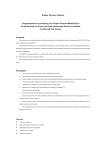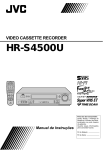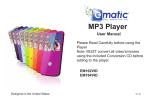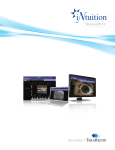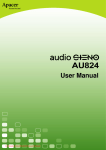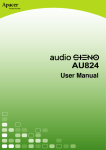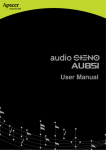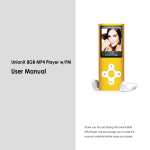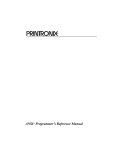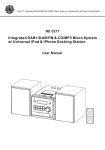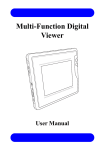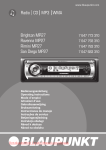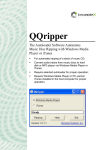Download 1 - The Singing Machine
Transcript
84mm wide
84mm tall
THE SINGING MACHINE INC.,
D/B/A SMC GLOBAL INC.,
6601 LYONS ROAD BUILDING A-7,
COCONUT CREEK, FL 33073
COPYRIGHT ©2010
Printed in China
THE SINGING MACHINE INC.,
D/B/A SMC GLOBAL INC.,
6601 LYONS ROAD BUILDING A-7,
COCONUT CREEK, FL 33073
COPYRIGHT ©2010
Impreso en China
SMD-322
TABLE OF CONTENTS
Precautions . . . . . . . . . . . . . . . . . . . . . 2
Operation–Recorder Mode . . . . . . . 20
FCC Declaration. . . . . . . . . . . . . . . . . . 3
• To Create a Voice Recording . . . . . 20
Location of Controls . . . . . . . . . . . . . . . 6
Operation–Photo Playback Mode . . 22
EIA Guidelines . . . . . . . . . . . . . . . . . . . 4
• To Listen to a Recording . . . . . . . . 21
Charging the Battery . . . . . . . . . . . . . . 7
• To View Photos . . . . . . . . . . . . . . . 22
Downloading and Transferring Files . . 9
• To View an Ebook . . . . . . . . . . . . . 23
Using the Neck Strap . . . . . . . . . . . . . . 8
Operation–Ebook Mode. . . . . . . . . . 23
Safely Remove Hardware . . . . . . . . . 15
Setting the Equalizer. . . . . . . . . . . . 24
• Turning the Power On/Off . . . . . . . 16
Setting the Power Saving. . . . . . . . 26
General Operation . . . . . . . . . . . . . . 16
Setting the Play Mode . . . . . . . . . . . 25
• Hold Switch . . . . . . . . . . . . . . . . . . 16
Setting the Backlight Timer . . . . . . 27
• Volume Setting. . . . . . . . . . . . . . . . 16
Troubleshooting Guide . . . . . . . . . . . . 29
• Headphones Jack . . . . . . . . . . . . . 16
Setting Menu. . . . . . . . . . . . . . . . . . . 28
Operation–Music Playback Mode . . 17
Formatting the Player. . . . . . . . . . . . . 31
• To Listen to MP3s/WMAs. . . . . . . . 17
Resetting the Unit . . . . . . . . . . . . . . . 32
• Forward/Reverse Skip . . . . . . . . . . 18
Specifications . . . . . . . . . . . . . . . . . . . 35
• High-Speed Music Search . . . . . . . 18
Video Conversion
Operation–Video(AMV) Playback Mode . 19
• To Play Video. . .. .. . . . . . . . . . . . . . 19
1
. . . . . . . . . . . . 33
PRECAUTIONS
COPYRIGHT:
• Distributing copies of MP3, WMA or AMV files without permission is a violation of
international copyright laws.
SAFETY:
• Vibration experienced during walking or exercising will not affect the player.
However, dropping the player or dropping a heavy object on the player may result
in damage or sound distortion.
• Avoid spilling any liquid onto or into the player.
• Do not leave the player in a location near heat sources; in a location subject to direct
sunlight, excessive dust, sand, moisture, rain or mechanical shock; on an unlevel
surface; or in a car with the windows closed during periods of excessive heat.
ROAD SAFETY:
• Do not use headphones while driving, cycling or operating any motorized vehicle. It
may create a traffic hazard and it is illegal in some areas. It can be potentially
dangerous to play your headset at a high volume while walking, especially at
pedestrian crossings. You should exercise extreme caution or discontinue use in
potentially hazardous situations.
FCC WARNING:
• This equipment may generate or use radio frequency energy. Changes or
modifications to this equipment may cause harmful interference unless the
modifications are expressly approved in the instruction manual. The user could
lose the authority to operate this equipment if an unauthorized change or
modification is made.
2
FCC DECLARATION
This device complies with Part 15 of the FCC rules. Operation is subject to the following
two conditions: 1) This device may not cause harmful interference, and 2) This device must
accept any interference received, including interference that may cause undesired
operation.
Warning: Changes or modifications to this unit not expressly approved by the party
responsible for compliance could void the user’s authority to operate the equipment.
NOTE: This equipment has been tested and found to comply with the limits for a Class B
digital device, pursuant to Part 15 of the FCC Rules. These limits are designed to provide
reasonable protection against harmful interference in a residential installation. This
equipment generates, uses and can radiate radio frequency energy and, if not installed
and used in accordance with the instructions, may cause harmful interference to radio
communications.
However, there is no guarantee that interference will not occur in a particular installation. If
this equipment does cause harmful interference to radio or television reception, which can
be determined by turning the equipment off and on, the user is encouraged to try to correct
the interference by one or more of the following measures:
• Reorient or relocate the receiving antenna.
• Increase the separation between the equipment and receiver.
• Connect the equipment into an outlet on a circuit different from that to which the receiver
is connected.
• Consult the dealer or an experienced radio/TV technician for help.
Shield cable must be used with this unit to ensure
compliance with class B FCC limits.
3
Dear Customer:
Selecting fine audio and video equipment such as the unit you’ve just purchased is
only the start of your musical enjoyment. Now it’s time to consider how you can
maximize the fun and excitement your equipment offers. This manufacturer and the
Electronic Industries Association’s Consumer Electronics Group want you to get the
most out of your equipment by playing it at a safe level. One that lets the sound come
through loud and clear without annoying blaring or distortion and, most importantly,
without affecting your sensitive hearing.
Sound can be deceiving. Over time your hearing “comfort level” adapts to higher
volumes of sound. So what sounds “normal” can actually be loud and harmful to your
hearing. Guard against this by setting your equipment at a safe level BEFORE your
hearing adapts.
To establish a safe level:
• Start your volume control at a low setting.
• Slowly increase the sound until you can hear it comfortably and clearly, and without
distortion.
Once you have established a comfortable sound level:
• Set the dial and leave it there.
Taking a minute to do this now will help to prevent hearing damage or loss in the future.
After all, we want you listening for a lifetime.
We Want You Listening For A Lifetime
Used wisely, your new sound equipment will provide a lifetime of fun and enjoyment.
Since hearing damage from loud noise is often undetectable until it is too late, this
manufacturer and the Electronic Industries Association’s Consumer Electronics Group
recommend you avoid prolonged exposure to excessive noise. This list of sound levels
is included for your protection.
4
Decibel
Level
30
40
50
60
70
80
Example
Quiet library, soft whispers
Living room, refrigerator, bedroom away from traffic
Light traffic, normal conversation, quiet office
Air conditioner at 20 feet, sewing machine
Vacuum cleaner, hair dryer, noisy restaurant
Average city traffic, garbage disposals, alarm clock at two feet
THE FOLLOWING NOISES CAN BE DANGEROUS UNDER CONSTANT EXPOSURE:
90
100
120
140
180
Subway, motorcycle, truck traffic, lawn mower
Garbage truck, chain saw, pneumatic drill
Rock band concert in front of speakers, thunderclap
Gunshot blast, jet engine
Rocket launching pad
Information courtesy of the Deafness Research Foundation.
We
Want You
LISTENING
For A Lifetime
NI
C
IND
N
A
EST. 1924
O
O C I A TI
IES
ELECT
TR
EIA
S
S
5
U
S
R
O
LOCATION OF CONTROLS
1
2
8
3
4
9
5
6
10
7
11
12
6
1.
2.
3.
4.
5.
Hold Switch
Strap Holder
Display
Mode/Enter Button
Navigation Up/Skip–Search m
Button
6. Power/Play/Pause ®p Button
7. Volume Button
8. Reset Button (Rear of Unit)
9. Microphone
10. Navigation Down/Skip–Search
l Button
11. Headphones Jack
12. USB Jack
CHARGING THE BATTERY
This unit has a built-in Lithium Polymer rechargeable battery. When the bars
in the battery indicator (in the display) become low (see Figure 1) and
especially when the Battery Low indicator appears, recharge the battery as
follows.
1. Connect the USB cable to the USB jack on the bottom of this
unit (as shown) and to the USB port on your computer. When
charging, the battery indicator will cycle from empty to full.
Once the battery is fully charged, the battery indicator will
stop cycling.
Full
battery
Low
Battery
Figure 1
NOTES:
• To disconnect this unit from your computer, make sure to follow the “Safely Remove
Hardware” instructions on page 15.
• It takes approx. 3 hours to charge the battery from empty to full. When fully charged,
the unit can playback for approx. 8 hours in Music Playback mode. (Actual playback
times may vary.)
• For data transfer, please use the USB cable (included) to connect the unit to
your computer.
7
1
USING THE NECK STRAP
2
Press the Tabs to release the Strap connector
from the Neck strap.
Insert the rope through the hole in the main unit.
Insert the Strap connector through the rope’s loop
until snug.
Connect the Neck strap back to the Strap connector.
Repeat for the other side of the unit. Adjust the next
strap as desired using the Loop Adjuster.
3
4
8
DOWNLOADING AND TRANSFERRING FILES
SUPPORTED OPERATING SYSTEMS
This unit is compatible with Microsoft Windows XP (Home or Professional
Edition with Service Pack 2 or higher) or Vista and Macintosh 9 or above.
Please refer to the following pages to learn how to: transfer files, convert music on
an audio CD into MP3 or WMA format using Windows Media Player 10, transfer
photos, transfer Ebooks and to safely remove your unit from the computer and how
to transfer files using a Macintosh.
NOTE: Visit www.Microsoft.com to download the corresponding Windows Media
Player for your computer.
MEDIA FILES SUPPORTED FORMATS
Audio Formats: MP3, WMA files
Photo Format: Baseline JPEGs
Ebook Format: TXT
Video Format: AMV (Use AMV conversion software (Included) to do the video conversion.
Please refer to the page 33 for video conversion.)
9
DOWNLOADING AND TRANSFERRING FILES (CONT.)
TRANSFERRING AUDIO FILES
You can download digital music files from the Internet or use encoding
software to convert music that you have on an audio CD into MP3 or WMA
format. Once these files are stored on your computer you can easily copy them
to your player.
If you have Windows Media Player 10 or 11, you can transfer music files
(MP3, WMA) to the player through the "Sync" function of Windows Media
Player 10 or 11. Connect your player to the USB port on your computer as
shown on page 7. Then, follow the procedure on page 12 to transfer music
files to the player.
If you do not have Windows Media Player 10 or 11, transfer music files as
follows:
1. Connect your player to the USB port on your computer using the USB
cable as shown above.
2. A "Removable Disk" window will automatically pop-up on your computer
screen.
3. To add more files and songs to your player, simply drag and drop MP3 or
WMA files/folders from anywhere on your computer into the "Removable
Disk" window.
10
DOWNLOADING AND TRANSFERRING FILES (CONT.)
CONVERTING AN AUDIO CD INTO MP3 OR WMA FORMAT
If you previously installed Windows Media Player 10 or 11 software, you can utilize it to convert
music on an audio CD into MP3 or WMA format as
follows:
1. Open the Windows Media Player 10 or 11
Browser, then click on the “Rip” icon on the top
tool bar. Insert a Music CD into the CD-Rom
drive of your computer.
2. Click on the “Tools” menu option at the top menu
bar, then click on “Options”; the Option setting
menu will appear. Click on Rip Music and set the
Rip Music to the desired location on your
computer. Then, set the desired format for the
newly ripped music (MP3 format or Windows
Media Audio format). Adjust the audio quality as desired.
When finished, click “OK” to confirm the settings.
3. Click on the “Rip Music” icon to start ripping the music to
your computer.
4. When the music tracks are ripped; connect the player to
your computer. Open the "Removable Disk" window and
open the ripped music location window.
5. To add the transferred/ripped music files/songs to your
player simply drag and drop the MP3 or WMA files into
the "Removable Disk" window.
6. When the files are finished loading into the player, you
can follow the “Safely Remove Hardware” procedure as
shown on page 15.
NOTES:
•
For Windows Media Player 11 users, please visit the following link for instructions on how to
rip (copy) songs from CDs to your computer:
http://www.microsoft.com/windows/windowsmedia/knowledgecenter/howto/mp11/rip.aspx
•
Windows Vista users must use Windows Media Player 11 to convert music on an audio CD
into MP3 or WMA format.
11
DOWNLOADING AND TRANSFERRING FILES (CONT.)
TRANSFERRING MP3/WMA FILES USING WINDOWS MEDIA PLAYER 10 (FOR WINDOWS XP
ONLY)
For Windows XP to transfer MP3/WMA files to the player,
follow the procedure described below using the previously
installed WMP (Windows Media Player) 10. Before beginning
the procedure, please connect the unit to the computer as
previously described.
1. Open the “Windows Media Player Browser 10” and click on
“Sync”.
2. Click on the “Sync List” pull-down menu to locate the music
files you wish to download. Then make sure to tick the box
next to the files.
3. Select the Portable Device ("Removable Disk") that you
want to copy to from the right side drop-down menu. Click
“Start Sync” to start transferring music files to the player.
4. After you are finished transferring all the desired files to your
unit, follow the “Safely Remove Hardware” procedure on
page 15.
NOTES:
• For Windows Media Player 11 users, please visit the
following link for instructions on how to sync files to this unit:
http://www.microsoft.com/windows/windowsmedia/knowledgecenter/howto/mp11/sync.aspx
• Windows Vista users must use Windows Media Player 11 to transfer music files to the player.
12
DOWNLOADING AND TRANSFERRING FILES (CONT.)
TRANSFERRING TEXT AND PHOTO FILES TO YOUR DIGITAL PLAYER
USING DRAG AND DROP METHOD USING WINDOWS
1.
2.
3.
Turn on your computer.
Turn on your digital player.
Connect the smaller end of the cable to the USB jack on the player and the
larger end of the cable to your USB port on your PC.
4.
A "Removable Disk" window will automatically pop-up on your computer
screen.
Simply drag and drop the files (Audio, Video, Photo, Ebook) inside the
6.
After you have finished your transfer, safely remove the player as described
on page 15.
Your player is ready to play the files you transferred.
5.
7.
"Removable Disk".
13
DOWNLOADING AND TRANSFERRING FILES (CONT.)
TRANSFERRING FILES TO YOUR DIGITAL PLAYER USING A MACINTOSH
COMPUTER
Make sure to use a Macintosh computer with an operating system of 9 or later to
transfer audio files.
1. Turn on your computer.
2. Turn on your digital player.
3. Connect the smaller end of the cable to the USB jack on the player and the
larger end of the cable to your USB port on your Macintosh.
4. Your computer will automatically recognize your player and mount a hard
disk icon onto your desktop.
5. Simply drag and drop the files (Audio, Video, Photo, Ebook) inside the
"Removable Disk".
6. After you have finished your transfer, put away the digital player hard disk
icon(s) by dragging it to the Trash icon or Control-click its icon and choose
Eject from the file menu or select Eject from the File drop down menu located
at the top of your screen. You can also use the keyboard shortcuts by
selecting the digital player hard disk icon and pressing the Command-E keys.
7. Your player is ready to play the files you transferred.
14
SAFELY REMOVE HARDWARE
SAFELY REMOVING YOUR PLAYER FROM THE COMPUTER
NOTE: To avoid damage to your player or data loss, always follow the procedure listed
below before disconnecting your player from the USB port on your computer.
Using your mouse, double click the "Safely Remove
Hardware" icon on the task bar.
From the "Safely Remove Hardware" window (shown lower
right), select "USB Mass Storage Device" and click the
"Stop" button. The "Stop a Hardware Device" window will pop-up.
Click "OK". When the "Safe to Remove Hardware" window is
displayed, you may remove the player from the USB cable or
remove the USB cable from the computer.
NOTES:
• If the “Safely Remove Hardware” icon is not displayed on the
task bar, please double click on My Computer. Right click on
“Removable Disk” and left click on “Eject”. Then it is safe to
remove the player from the computer.
• If you are using Windows XP/Vista and the Windows Media
Player 10 or 11 software is already installed, then you do not
need to follow the above "Safely Remove Hardware" procedure.
15
GENERAL OPERATION
TURNING THE POWER ON/OFF
1
To turn the unit on, press and hold the
Power/Play/Pause ®p button; the Welcome
screen will appear for a few moments followed
by the MP3 screen. To turn the unit off, press
and hold the Power/Play/Pause ®p button.
Do not release the Power/Play/Pause ®p
button until the Good Bye screen appears.
Wait a minute after turning off the unit to turn
on the unit again.
HEADPHONES JACK
1
HOLD SWITCH
1
Slide the Hold switch to the Lock position to lock
the buttons; This is useful, for example,when
you do not want the file changed by
accidentally pressing a button. Slide the Hold
switch to the Unlock position to cancel the Hold
function;
VOLUME SETTING
1
Plug the headphones (included) into the
Headphones jack on the side of the unit.
16
3
1
2
To control the volume, while in the Music or Voice
modes, press the Volume button 1; the Volume
Setting screen will appear. Within four seconds,
press the Navigation Down/Skip–Search l button
2 to raise or Navigation Up/Skip–Search m
button 3 to lower the volume. The volume level is
indicated on the screen by a number (0-30).
OPERATION–MUSIC PLAYBACK MODE
TO LISTEN TO MP3s/WMAs
This unit supports the following audio formats: MP3, MPEG 1/2/2.5 Layer 3 with a bit rate of 32320 kbps and WMA files.
1
3
2(7
1
2
Turn the unit on as shown on page 16.
If the unit is already on and in another mode,
press and hold the Mode/Enter button 1;
the Mode Menu screen will appear. Select
Music using the Navigation Down/
Skip–Search l button 2 or Navigation
Up/Skip–Search m button 3 then press
the Mode/Enter button 1 again to select it.
Press the Power/Play/Pause ®p button to
start playback. The MP3 information will
scroll across the screen.
NOTES:
• See pages 10-12 and 14 for information on transering MP3/WMA files to this unit.
• You can pause playback at anytime by pressing the Power/Play/Pause ®p button; the Pause icon will appear on
screen and the song will remain paused until the button is pressed again.
• To set the Play Mode (Normal, Repeat One,Folder, Repeat Folder, Repeat All, Random, Intro) setting refer to page 25.
• To set the Equalizer, see page 24.
• (AUTO RESUME): Each time you exit the Music Playback mode or Voice Playback mode and turn the unit off,
when the unit is turned back on or you enter the Music Playback mode or Voice Playback mode again, this unit will
resume at the beginning of the last track which was playing before turning the power off.
• While playing the music, press Mode/Enter button ®p to go to submenu. (Repeat, Equalizer, Tempo Rate, Replay,
Replay Times, Replay Gap). Press navigation Down/Skip-Search l or Up m button to select and press mode/enter
button to enter. Press Power/Play/Pause ®p button to return to previous menu.
• While the music is stop/pause playing, press mode/enter button to go to submenu(Local Folder, Delete, Delete All). Press
navigation Down/Skip-Search l or m Up button to select and press mode/button to enter. Press Power/Play/Pause ®p
to return to previous menu.
17
OPERATION–MUSIC PLAYBACK MODE (CONTINUED)
HIGH-SPEED MUSIC SEARCH
1
2
1
During playback, press and hold the
Navigation Down/Skip–Search l 1 or Up/m
2 button to move the player forward or
backward within a file to locate a specific
musical passage. The player will move
forward or backward at high speed as long
as the button is held. When you release the
button, normal playback will resume.
FORWARD/REVERSE SKIP
1
2
During playback, press the Navigation Up/
Skip–Search m button to skip the player
back to the beginning of the currently playing
file. Press the Navigation Up/Skip–Search m
button repeatedly to skip the player to
previous track.
During playback, press the Navigation
Down/Skip–Search l button to advance the
player to the beginning of the next file. Press
the Navigation Down/Skip–Search l button
repeatedly to skip the player to next track.
18
OPERATION–VIDEO(AMV) PLAYBACK MODE
TO PLAY VIDEO(AMV)
This unit supports the following video formats: AMV(Need AMV conversion software (Included)
to process the video conversion. Please refer to the page 33 for video conversion).
1
2
2
3
1
Turn the unit on as shown on page16 . If the unit Press the Power/Play/Pause ®p button to
start playback.
is already on and in another mode, press and
hold the Mode/Enter button 1 ; the mode
menu screen will appear. Select AMV using
the navigation Down/Skip-Search l button
2 or navigation Up/Skip-Search m button 3
then press the Mode/Enter 1 again to select it.
NOTE:
While the video(AMV File) is stopped/paused, press Mode/Enter to go to submenu(Local
Folder, Delete, Delete All, Repeat). Press navigation Down/Skip-Search l button or Up m
button to select and press Mode/Enter button to enter. Press Power/Play/Pause ®p to return
menu.
19
OPERATION–RECORDER MODE
TO CREATE A VOICE RECORDING
1
3
2
1
2
Turn the unit on as shown on page 16. Press
and hold Mode/Enter button 1; the
Mode Menu screen will appear. Select
Record using the Navigation Down/
Skip–Search l button 2 or Navigation Up/
Skip–Search m button 3.
Press the Mode/Enter button to select it;
The Elapsed time will appear in the middle
of the display.
3
Speak into the microphone, Press the
Power/Play/Pause ®p button to start/pause
recording, and press again to resume
recording. Press and hold Power/Play/
Pause ®p button to stop and save the
recording.
20
OPERATION–RECORDER MODE (CONTINUED)
TO LISTEN TO A RECORDING
1
2
2
3
1
To listen to the recording, while in the main
menu, select Voice using the Navigation
Down/Skip–Search l button 1 or
Navigation Up/Skip–Search m button 2,
then press the Mode/Enter button 3 again to
select it.
Press the Power/Play/Pause ®p button to
start playback. The WAV information will
scroll across the screen.
NOTE: Play/Pause, Forward/Reverse Skip and High-Speed Search work the same way in
Recording Playback mode as they do in Music Playback mode. See pages 17 and 18 for more
details.
• While playing the recording, press Mode/Enter button to go into submenu. (Repeat, Tempo
Rate,Replay). Press navigation Down/Skip-Search l or Up m button to select and press
Mode/Enter button to enter. Press Power/Play/Pause ®p button to return to previous menu
• While the recording is stop/pause playing, press Mode/Enter button to go to submenu.
(Local Folder, Del. File?, Delete All). Press navigation Down/Skip-Search l or Up m button
to select and press Mode/Enter button to enter. Press Power/Play/Pause®p to return to
previous menu.
21
OPERATION–PHOTO PLAYBACK MODE
TO VIEW PHOTOS–This unit supports baseline JPEGs.
1
3
2
Turn the unit on as shown on page 16. Press
and hold the Mode/Enter button 1; the
Mode Menu screen will appear. Select
Photo using the Navigation Down/
Skip–Search l button 2 or Navigation
Up/Skip–Search m button 3,then press the
Mode/Enter button 1 again to select it.
3
2
2
1
3
Press the Power/Play/Pause ®p button to
view the photo.
1
Press the Navigation Down/Skip–Search
l 1 or Up/m 2 button to skip to the next
or previous photo. Press Power/Play/
Pause button ®p button 3 and return to
Photo Menu.
NOTE: See pages 13 and 14 for information to transfer photo files to this unit.
• Press Mode/Enter button to go to submenu(Local Folder, Play Set(Manual Play, Auto Play),
Delete, Delete all). Press navigation Down/Skip-Search l or Up m button to select and press
Mode/Button to enter. Press Power/Play/Pause ®p to return to previous menu.
22
OPERATION–EBOOK MODE
TO VIEW AN Ebook–This unit supports books in txt format.
1
3
3
1
2
Turn the unit on as shown on page 16. Press
and hold the Mode/Enter button 1; the
Mode Menu screen will appear. Select Ebook
using the Navigation Down/Skip–Search l
button 2 or Navigation Up/Skip–Search m
button 3.
NOTES:
•
Press the Power/Play/Pause ®p button once to
return to the Ebook Menu screen, and press and
hold again to return to the Main menu screen.
•
See pages 13 and 14 for information on
uploading Ebook txt files to this unit.
•
White reading the text, press Mode/Enter button
to go to submenu .(Favourites Select, Delete
Bookmarks Add). Press navigation down/
Skip-Search l or Up m button to select and
press Mode/Enter button to enter. Press
Power/Play/Pause ®p button to return to
return to previous menu.
•
White not reading the text, press Mode/Enter
button to go to submenu(load folder, Play set,
delete, delete all). Press navigation Down/
Skip-Search l or Up m button to select and
press Mode/Button to enter. Press Power/
Play/Pause ®p to return to previous menu.
23
3
1
2
Press the Power/Play/Pause ®p button to
select the title; the book will appear. If there
is more than one screen, use the
Navigation Down/Skip–Search l button 2
to scroll to the right or Navigation
Up/Skip–Search m button 3 to scroll to the
left.
SETTING THE EQUALIZER
SETTING THE EQUALIZER
1
2
1
3
2
Turn the unit on as shown on page 16. Press and
hold the Mode/Enter button 1; the Mode Menu
screen will appear. Select music using the
Navigation Down/Skip–Search l button 2 or
Navigation Up/Skip–Search m button 3, then
press theMode/Enter button 1 again to select it.
3
2
3
1
Select a desired Equalizer setting (Natural
[Normal], Rock, Pop, Classic [Classical],
Soft, Jazz or DBB[XBass]) using the
Navigation Down/Skip–Search l button
1 or Navigation Up/Skip–Search m button
2, then press the Mode/Enter button 3 to
confirm and return to music menu.
24
3
1
2
While playing the music, press Mode/Enter
button 1 to go to submenu. Select Equalizer
in submenu using the Navigation Down/
Skip-Search l button 2 or Navigation Up/
Skip-Search m button 3 , then press the
Mode/Enter button 1 to confirm.
SETTING THE PLAYMODE
SETTING THE PLAY MODE
1
2
1
3
2
3
1
2
Turn the unit on as shown on page 16. Press and While playing the music, press Mode/Enter 1
hold the Mode/Enter button 1; the Mode Menu to go to submenu. Select Repeat in submenu
using the Navigation Down/Skip-Search l
screen will appear. Select music using the
button 2 or Navigation Up/Skip-Search m button
Navigation Down/Skip–Search l button 2 or
Navigation Up/Skip–Search m button 3, then 3 then press the Mode/Enter button 1 to
press the Mode/Enter button 1 again to select it. confirm.
3
2
3
1
Select a desired Repeat setting (Normal,
Repeat One, Folder, Repeat Folder, Repeat All,
Random, Intro) using the Navigation Down/
Skip–Search l button 1 or Navigation Up/
Skip–Search m button 2, then press the
Mode/Enter button 3 to confirm and return to
Setting menu.
25
SETTING THE POWER SAVING
SETTING THE POWER SAVINGS
1
3
1
2
Turn the unit on as shown on page 16. Press and
hold the Mode/Enter button 1; the Mode Menu
screen will appear. Select Setup using the
Navigation Down/Skip–Search l button 2 or
Navigation Up/Skip–Search m button 3, then
press the Mode/Enter button 1 again to select it.
3
1
Press the Mode/Enter 1 to select Off Time.
NOTE:
2
2
3
1
Select Power off using the Navigation
Down/Skip–Search l button 1 or
Navigation Up/Skip–Search m button 2,
then press the Mode/Enter button 3 to
select it.
4
2
3
1
Select a desired Power Savings off Time
setting(Disable;10, 20... or 60seconds) using
the Navigation Down/Skip–Search l button
1 or Navigation Up/Skip–Search m button 2,
then press the Mode/Enter button 3 to
confirm and return to Setting menu.
• This sets the time interval of the unit will stay on during no operation.
26
SETTING THE BACKLIGHT TIMER
SETTING THE BACKLIGHT TIMER
1
2
1
3
2
Turn the unit on as shown on page 16. Press and
hold the Mode/Enter button 1; the Mode Menu
screen will appear. Select Setup using the
Navigation Down/Skip–Search l button 2 or
Navigation Up/Skip–Search m button 3, then
press the Mode/Enter button 1 again to select it.
3
2
3
1
Select Darkmode using the navigation Down/
Skip-Search l button 1 or Up m button 2
then press the Mode/Enter button 3 to select it.
27
2
3
1
Select LCD Set using the Navigation
Down/Skip–Search l button 1 or
Navigation Up/Skip–Search m button 2,
then press the Mode/Enter button 3 to
select it.
4
2
3
1
Select a desired backlight(Darkmode). (disable;
0, 2, 4,...60) using the navigation Down/SkipSearch l button 1 or Up m button 2 and press
Mode/Enter button 3 to confirm and return to
setting menu.
1
SETTING MENU
3
2
1
2
Turn the unit on as shown on page 16. Press and
hold the Mode/Enter button 1; the Mode
Menu screen will appear. Select Setup using
the Navigation Down/Skip–Search l button 2
or Navigation Up/Skip–Search m button 3,
then press the Mode/Enter button 1 again to
select it.
NOTE:
2
3
1
Select the desired submenu(LCD Set,
Language, Power Off, Memory Info,
Firmware Verson) using the navigation
Down/Skip–Search l button 1 or
Navigation Up/Skip–Search m button 2,
then press the Mode/Enter button 3 to
select it and make the setting. Press Power/
Play/Pause ®p to return previous menu.
• Playmode setting and equalizer setting are set under music Playback Mode.
• There are more settings which select under each mode. Please refer to the note
under each operation in this user manual.
28
TROUBLESHOOTING GUIDE
If you experience a problem with this unit, check the chart below before calling for service.
SYMPTOM
Unit can not
turn on.
No sound.
The computer can not
recognize the
player.
CAUSE
Battery is low/empty.
Power is not
turned on.
Headphones are not
inserted.
Volume is set too low.
The media files
are corrupted.
No files are in the
player.
The player is
not securely connected.
Computer is not
compatible.
29
SOLUTION
Recharge battery as
described on page 7.
See page 16 for how to turn
on the power.
Insert headphones.
Raise the volume as described
on page 16.
Download uncorrupted
files.
Upload files to the unit as
described on pages 10-14.
Make sure player is
securely connected.
Supported OS: Windows XP
and Vista and Mac OS 9/X.
TROUBLESHOOTING GUIDE (CONTINUED)
SYMPTOM
No button works.
CAUSE
The Lock feature is
activated.
SOLUTION
Deactivate Lock feature as
described on page 16.
Unit acting abnormally
Unit needs to be reset
Reset unit as described
on page 32
30
.
FORMATTING THE PLAYER
Formatting the Player
WARNING! Do not format this player unless it stops working and you are
instructed to do so by technical support personnel.
1. Use the USB cable to connect the
player and the computer.
2. Double click on My Computer, then
right click "Removable Disk" and left
click on "Format".
3. At the "Format" window, select "FAT
32" from the file system pull-down
menu, then click "Start" to format the
unit (see figure above).
NOTE: Make sure you have selected "FAT 32" at the file system pull-down
menu; otherwise, after formatting, the player will not work properly. Then,
click OK to confirm and the player will start to format. When finished, click
"Close" to close the Format window.
31
RESETTING THE UNIT
If the unit acts abnormally, reset the unit by inserting a thin object (such as a paper clip)
into the recessed Reset button. For the Reset button, see page 6 for the button's
location.
32
VIDEO CONVERSION
1. Install the software WinMPG_VideoConvert_Setup from CD ROM supplied.
2. Run the software WinMPG Video Convert after installed.
33
VIDEO CONVERSION
3. Press the button MORE in the main interface. And then select the AMV
format for video conversion.
4. Press the button Add File. Select the movie you want to do the video
conversion to AMV format.
5. Select the destination you want to save the converted AMV video file.
6. Select the 128×128 format in the AMV Video File Width in setting.
7. After setting, press Start To Convert.
8. The converted AMV Video file will be saved in your selected destination after conversion.
9. Transfer the converted files to your digital player using drag and drop method using
Windows for video playback.
NOTES:
Below are the file formats, which the Video conversion software can support for video
conversion to AMV format:
1) Windows Media file format which the expanded name is WMV, ASF
2) MPEG1 file format which the expanded name is MPG, MPEG, MPEG1 file format
3) Real play file format which the expanded name is RM, RAM, RMVB
4) QuickTime file format which the expanded name is MOV
5) MPEG2 file format which the expanded name is VOB
6) MPEG2 file format which the expanded name is SWF
34
Audio
File Support
General
SPECIFICATIONS
Frequency Range
Headphones Output
S/N Ratio
MP3
WMA
Picture
Ebooks
Video
Dimension
Weight
USB
Built-in Memory
Built-in Battery
Max. Playtime
Supported OS
Operating Temperature
LCD Display
20Hz–20KHz
5mW, 32ohm (Max Vol)
90dB (MP3)
MPEG 1/2/2.5 Layer 3
with a Bit Rate of 32-320 kbps
Windows Media Audio
with a Bit Rate of 48-192 kbps
Baseline JPEGs
TXT (Text) file
AMV
1.7 (W) x 3.8 (L) x 0.4 (D) inches
43 grams
USB 2.0
2GB
Li-Polymer Rechargeable battery
250mAh
approx.8 hrs in Music Playback mode
Windows XP and Vista and Mac 9 or later
23° F to 104° F (-5° C to 40° C)
1.44" (measured diagonally)
Specifications are subject to change without notice.
35




































